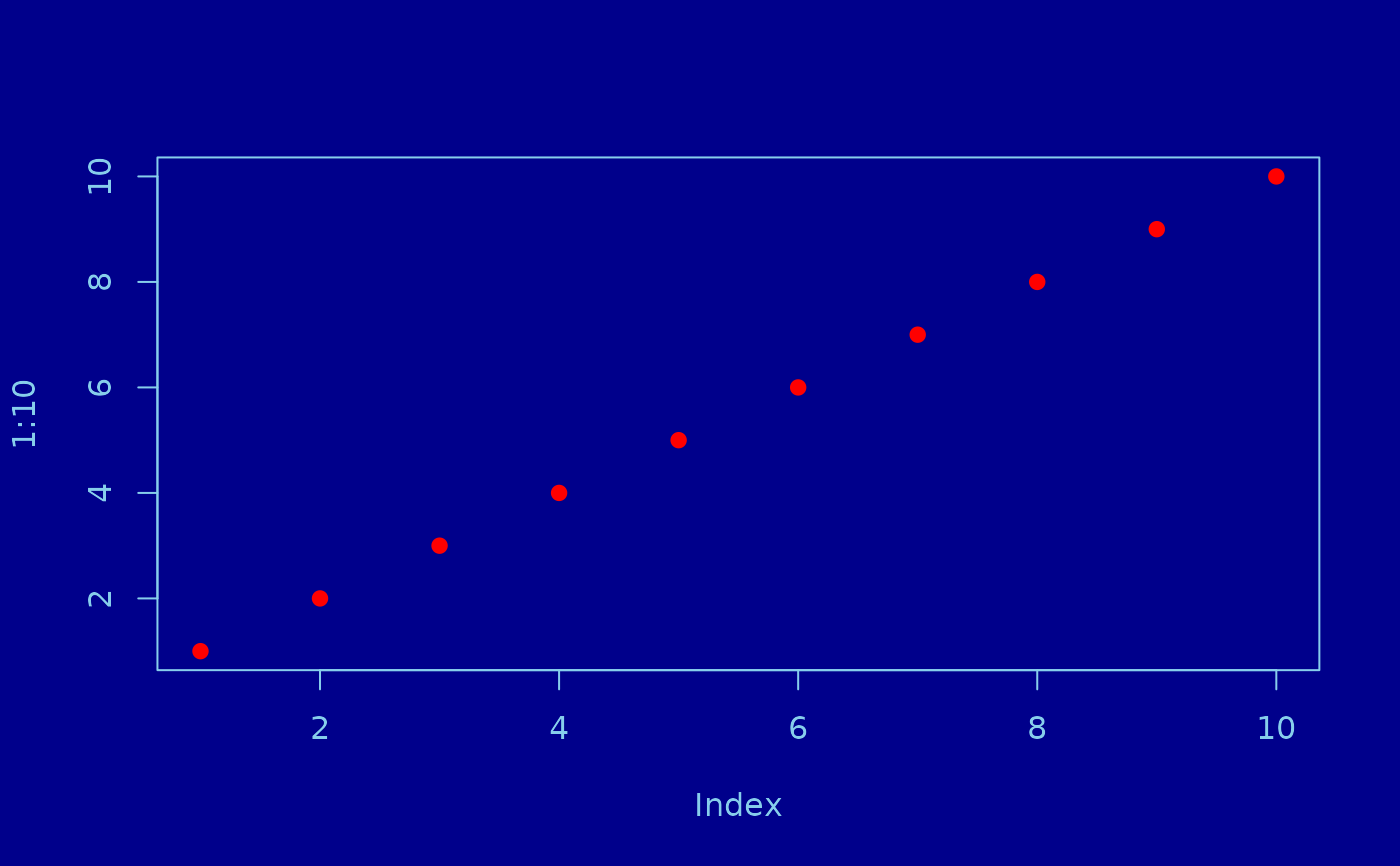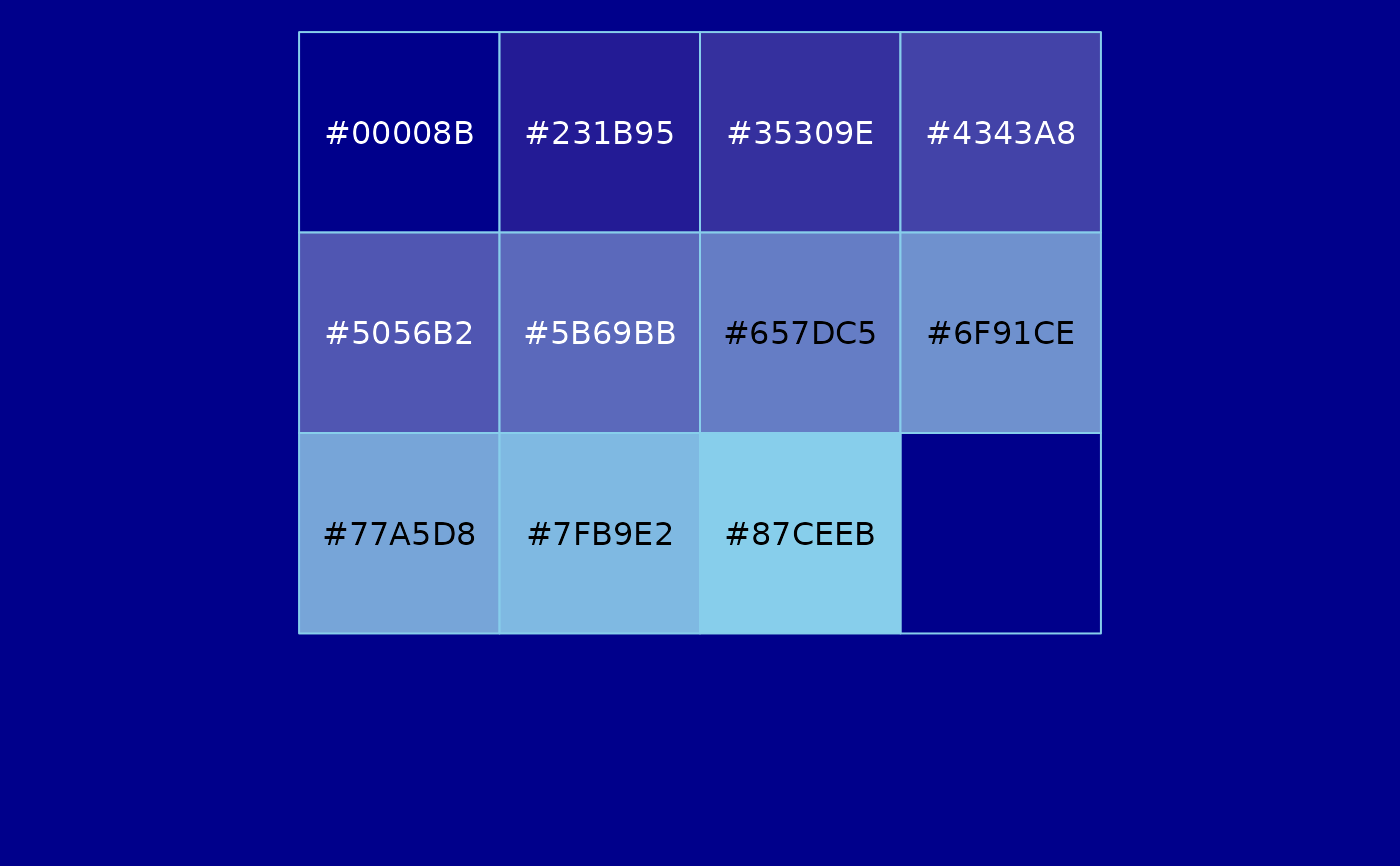These functions are helpful for getting and/or temporarily activating a
thematic_theme().
thematic_with_theme(theme, expr)
thematic_local_theme(theme, .local_envir = parent.frame())
thematic_set_theme(theme)
thematic_get_theme(resolve = TRUE)
thematic_get_option(name = "", default = NULL, resolve = TRUE)
thematic_get_mixture(amounts = 0.5, default = NULL)Arguments
- theme
a
thematic_theme()object (or a return value of thematic_on/thematic_get_theme()) orNULL(in which casethematic_off()is called).- expr
R code that produces a plot.
- .local_envir
The environment to use for scoping.
- resolve
whether or not
'auto'values should be resolved before returning- name
a theme element name (e.g.,
fg,bg, etc.)- default
a default value to return in the event no thematic theme is active.
- amounts
value(s) between 0 and 1 specifying how much to mix
bg(0) andfg(1).
Value
the result of expr.
Functions
thematic_with_theme(): similar tothematic_on(), but for an single plot.thematic_local_theme(): similar tothematic_with_theme(), but de-couples the theme from the plot expression.thematic_set_theme(): set a giventhemeobject as the current theme.thematic_get_theme(): obtain the currenttheme.thematic_get_option(): obtain a particularthemeoption (and provide adefaultif nothemeis active).thematic_get_mixture(): obtain a mixture of the currenttheme'sbgandfg.
Examples
# Use thematic_with_theme() for a one-time use of thematic
thematic_with_theme(
thematic_theme("darkblue", "skyblue", accent = "red"),
plot(1:10, col = thematic_get_option("accent"), pch = 19)
)
 # Use thematic_set_theme() if doing something more complicated
# like programming on top thematic (without causing side effects)
my_plot <- function(expr, las = 3, ...) {
old_theme <- thematic_on("black", "white")
on.exit(thematic_set_theme(old_theme), add = TRUE)
opts <- par(las = las)
on.exit(par(opts), add = TRUE)
# Imagine some more customization with ...
force(expr)
}
my_plot(plot(1:10))
# Use thematic_set_theme() if doing something more complicated
# like programming on top thematic (without causing side effects)
my_plot <- function(expr, las = 3, ...) {
old_theme <- thematic_on("black", "white")
on.exit(thematic_set_theme(old_theme), add = TRUE)
opts <- par(las = las)
on.exit(par(opts), add = TRUE)
# Imagine some more customization with ...
force(expr)
}
my_plot(plot(1:10))
 thematic_off()
thematic_get_option("bg", "white")
#> [1] "white"
thematic_on(bg = "red")
thematic_get_option("bg", "white")
#> Warning: thematic was unable to resolve `fg='auto'`. Try providing an actual color (or `NA`) to the `fg` argument of `thematic_on()`. By the way, 'auto' is only officially supported in `shiny::renderPlot()`, some rmarkdown scenarios (specifically, `html_document()` with `theme!=NULL`), in RStudio, or if `auto_config_set()` is used.
#> [1] "red"
thematic_off()
thematic_with_theme(
thematic_theme("darkblue", "skyblue"),
scales::show_col(thematic_get_mixture(seq(0, 1, by = 0.1)))
)
thematic_off()
thematic_get_option("bg", "white")
#> [1] "white"
thematic_on(bg = "red")
thematic_get_option("bg", "white")
#> Warning: thematic was unable to resolve `fg='auto'`. Try providing an actual color (or `NA`) to the `fg` argument of `thematic_on()`. By the way, 'auto' is only officially supported in `shiny::renderPlot()`, some rmarkdown scenarios (specifically, `html_document()` with `theme!=NULL`), in RStudio, or if `auto_config_set()` is used.
#> [1] "red"
thematic_off()
thematic_with_theme(
thematic_theme("darkblue", "skyblue"),
scales::show_col(thematic_get_mixture(seq(0, 1, by = 0.1)))
)
